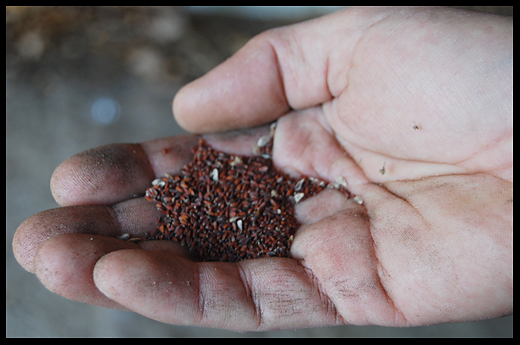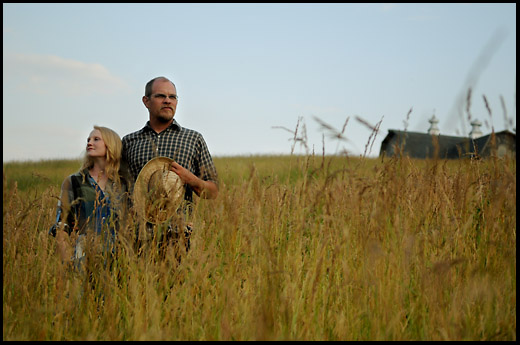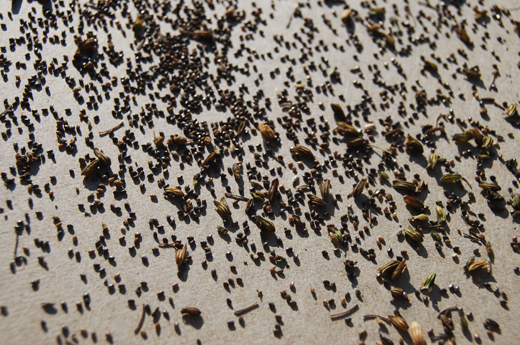
by guest blogger Tim Mountz of Happy Cat Farm
Sometimes the greatest things in life are the things that just happen to you and not the ones that you lay out in great plans. I did not choose to be a seed-growing farmer; it chose me.
In 1993, my grandfather was killed in a car accident, and at his passing I was given a jar of beans that turned out to have great historical and cultural importance. Then, a few years later, while I was living in Philadelphia, my aunt got me a book for Christmas called Heirloom Vegetable Gardening by William Woys Weaver. Turned out he lived in Devon, not too far from me. So I contacted him and we scheduled a meet-up. I took the R5 train to his house, and after a nice long afternoon of talking about gardening and seeds, I ended up working with him for a year.
Over that time, we made it a mission to try to figure out just what kinds of beans were in the jar my grandfather left me. Some of the beans are still unknown to us, and we’re still working on finding out just what they are. But some he knew. Once, he pulled a purple one out of the jar, a deep dark-purple, almost black, bean with tan speckles. He held it in is hand and then slowly poured the rest into my hands and said, “This one, this one is extinct!” It was a ‘Stoltzfus’ string bean. The ‘Stoltzfus’ string bean was a type saved by the Beachy Amish in Lancaster County. It was grown from one of the first beans brought to this country on the first New World expeditions. What a gift! What a great connection to time and culture! Food is truly culture.
All four of my grandparents where raised on farms and spoke German as a first language. My grandfather left the farm to work in a scale factory, but it was never far from him. He had a large vegetable plot (almost an acre) that he called the truck patch, though he did not truck any of it to market as its name would suggest. Roots that run deep have a mysterious way of returning to the surface to start growing anew. And in the 19 years since I first held that little jar in my hands, I’ve learned a lot. Including that one of my favorite things about being a seed farmer is threshing.
Threshing (not to be confused with thrashing, which is the art of being rad on a skateboard) is the art of smashing. Or, more specifically, it is the act of separating the seed from husk, which involves a lot of smashing. In nature, when plants are trying to spread their seed, the pods become very dry and then shatter, releasing the seeds. But this shattering isn’t conducive to good seed collecting, so way back, some smart hunter-gatherers started to select seeds from pods that didn’t shatter as easily when they dried. And, ta-da! Agriculture was born, and with it, threshing.
Threshing is one of the truest art forms I have discovered. It’s not only an ancient skill of balance and rhythm, but it’s also an amazing expression of freedom and connectivity to our food system (and a good workout to boot.) Anyone can become a seed saver. Just let one of those wonderful arugula plants flower and it will make green seed pods. The pods will start to turn brown, and when they are all brown, collect them into a paper bag and let them stand in a dry place out of the sun. I do this for a month. When they’re ready you’ll hear seeds rattling in the bottom of the bag.
Here’s what the process looks like:
STEP 1: Drying
Let your plants flower and go to seed. Then wait until the seedpods are almost dry (they’ll turn brown) and collect them into a paper bag. Store them away in a cool, dry place for about a month to finish drying.
STEP 2: Threshing (aka beating or flailing)
This is the fun part, where you get to use your muscles and really connect with your inner early agriculturist. Here at Happy Cat Farm, we lay the seedpods out on a tarp, fold the tarp over, and stomp away. Seeds are hard little things, so don’t be afraid to really smash them. What you’re doing is smashing open the seedpod covers and breaking up any dried stems that are in there. We use big tarps, but anything that you can gather up will do just fine. You can really get lost in the rhythm, the percussive music of threshing. It’s like a drum circle celebrating harvest.
STEP 3: Winnowing
If threshing is the music, winnowing is the dance. In this step you are blowing the chaff, or outer casing, away from the seed. The best way to do this is to take a handful of your threshed material and put it on a plate. The heavy seeds will tend to roll to the middle and the chaff will hang out around the outside. Blow a small breath over the plate and watch the chaff fly away (you may want to be outside at this point, but not on a really windy day). Threshed seed poured from one hand to another in a light wind is so pure an act it seems to shine light on humanity and our deep connection to nature. Picture a woman standing on a pile of grain with a basket, casting its contents upward and letting the wind separate the heavy seed from the lighter chaff. This looks easy, but it is so hard you can’t believe that this is how seeds have been cleaned for thousands of years. Winnowing is a learned skill that is not easy to master. The first time I tried, I ended up picking up beans up off the ground for about an hour. So be patient and kind to yourself.
Now that you have clean seeds you can put them in an envelope, or any other breathable container, label them, and store them away from humidity and sunlight. Be sure to make notes about what worked and what didn’t so you remember for next time. Oh yeah, and don’t forget to then plant them and bask in the circle of life.
Well, I have tons of seeds to clean so I had better get to the barn. I have an afternoon of drumming and dancing ahead of me.
 Tim and his wife Amy own Happy Cat Farm, an organic farm and lifestyle brand located just outside of Kennett Square, PA [www.happycatorganics.com].
Tim and his wife Amy own Happy Cat Farm, an organic farm and lifestyle brand located just outside of Kennett Square, PA [www.happycatorganics.com].










Thanks for the article. It feeds my ancestral spirit energy.
The only thing I’ve come close to threshing was when I grew my own popcorn. After the kernels dried and we separated them from the cob, there were still lots of little bits of papery stuff. I put it all in a big strainer, went outside and gently tossed the corn into the air. Even though there didn’t even seem to be a breeze, it was fascinating to watch the little bits of chaff waft away. For a moment, I did feel connected with another time period and culture when that would have been totally normal. By the way, that home grown popcorn was the best popcorn I have ever tasted.
This is my favorite blog so far! I love seeds, and chuckled as I read about winnowing. Yep, I’ve lost a few tiny seeds to the wind when I just couldn’t wait for a calm day.
What a very beautiful post this is. Your passion and writing about the lost art of threshing is pure poetry. Thank you for sharing!
I wonder what happen to the seeds that Legazpi reported to the king in 1565 that grew after three to four days in Cebu if they are still extant today.